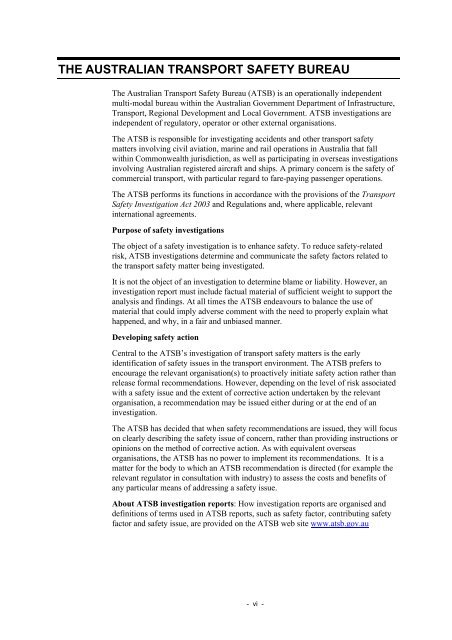Amateur-built and experimental aircraft - Australian Transport Safety ...
Amateur-built and experimental aircraft - Australian Transport Safety ...
Amateur-built and experimental aircraft - Australian Transport Safety ...
You also want an ePaper? Increase the reach of your titles
YUMPU automatically turns print PDFs into web optimized ePapers that Google loves.
THE AUSTRALIAN TRANSPORT SAFETY BUREAU<br />
The <strong>Australian</strong> <strong>Transport</strong> <strong>Safety</strong> Bureau (ATSB) is an operationally independent<br />
multi-modal bureau within the <strong>Australian</strong> Government Department of Infrastructure,<br />
<strong>Transport</strong>, Regional Development <strong>and</strong> Local Government. ATSB investigations are<br />
independent of regulatory, operator or other external organisations.<br />
The ATSB is responsible for investigating accidents <strong>and</strong> other transport safety<br />
matters involving civil aviation, marine <strong>and</strong> rail operations in Australia that fall<br />
within Commonwealth jurisdiction, as well as participating in overseas investigations<br />
involving <strong>Australian</strong> registered <strong>aircraft</strong> <strong>and</strong> ships. A primary concern is the safety of<br />
commercial transport, with particular regard to fare-paying passenger operations.<br />
The ATSB performs its functions in accordance with the provisions of the <strong>Transport</strong><br />
<strong>Safety</strong> Investigation Act 2003 <strong>and</strong> Regulations <strong>and</strong>, where applicable, relevant<br />
international agreements.<br />
Purpose of safety investigations<br />
The object of a safety investigation is to enhance safety. To reduce safety-related<br />
risk, ATSB investigations determine <strong>and</strong> communicate the safety factors related to<br />
the transport safety matter being investigated.<br />
It is not the object of an investigation to determine blame or liability. However, an<br />
investigation report must include factual material of sufficient weight to support the<br />
analysis <strong>and</strong> findings. At all times the ATSB endeavours to balance the use of<br />
material that could imply adverse comment with the need to properly explain what<br />
happened, <strong>and</strong> why, in a fair <strong>and</strong> unbiased manner.<br />
Developing safety action<br />
Central to the ATSB’s investigation of transport safety matters is the early<br />
identification of safety issues in the transport environment. The ATSB prefers to<br />
encourage the relevant organisation(s) to proactively initiate safety action rather than<br />
release formal recommendations. However, depending on the level of risk associated<br />
with a safety issue <strong>and</strong> the extent of corrective action undertaken by the relevant<br />
organisation, a recommendation may be issued either during or at the end of an<br />
investigation.<br />
The ATSB has decided that when safety recommendations are issued, they will focus<br />
on clearly describing the safety issue of concern, rather than providing instructions or<br />
opinions on the method of corrective action. As with equivalent overseas<br />
organisations, the ATSB has no power to implement its recommendations. It is a<br />
matter for the body to which an ATSB recommendation is directed (for example the<br />
relevant regulator in consultation with industry) to assess the costs <strong>and</strong> benefits of<br />
any particular means of addressing a safety issue.<br />
About ATSB investigation reports: How investigation reports are organised <strong>and</strong><br />
definitions of terms used in ATSB reports, such as safety factor, contributing safety<br />
factor <strong>and</strong> safety issue, are provided on the ATSB web site www.atsb.gov.au<br />
- vi -

















